Abstract
STUDY OBJECTIVE--The aim was to investigate risk factors for cancer of the buccal and labial mucosa in Kerala, southern India. DESIGN--The investigation was a case-control study. SETTING--Regional Cancer Centre, Trivandrum, Kerala, and local teaching hospitals. PARTICIPANTS--Cases were all those registered with oral cancers at the Regional Cancer Centre during 1983 and 1984 (n = 414). Controls (n = 895) were selected from admissions to the cancer centre who were found to have non-malignant conditions, or from patients attending outpatients in teaching hospitals of Trivandrum medical college with non-malignant conditions. MEASUREMENTS AND MAIN RESULTS--The risk in males of the following habits was investigated: pan (betel)-tobacco chewing, bidi and cigarette smoking, drinking alcohol, and taking snuff. Only pan-tobacco chewing was investigated in females as very few indulged in other habits. Among males predisposing effects were found for pan-tobacco chewing (p less than 0.001), bidi smoking (p less than 0.001), drinking alcohol (p less than 0.001), and taking snuff (p less than 0.01). As in males, pan-tobacco chewing also had a predisposing effect in females (p less than 0.001). Duration of use was a better predictor of risk than either daily frequency of use or total lifetime exposure, both for pan-tobacco chewing (especially if the habit started before age 21 years) and bidi smoking. However, there were also very high risks associated with the current occasional use of both factors. Pan-tobacco chewing was the most important risk factor, with relative risk of 13.24 with 31-40 years' use, and 37.75 with greater than 40 years' use among males. Corresponding relative risks in females were 21.30 and 54.93. No effect of cigarette smoking was observed (relative risk 0.64, p greater than 0.1). CONCLUSIONS--A substantial majority of cases of buccal and labial cancers are attributable to chewing pan-tobacco. This has obvious implications for instituting preventive measures.
Full text
PDF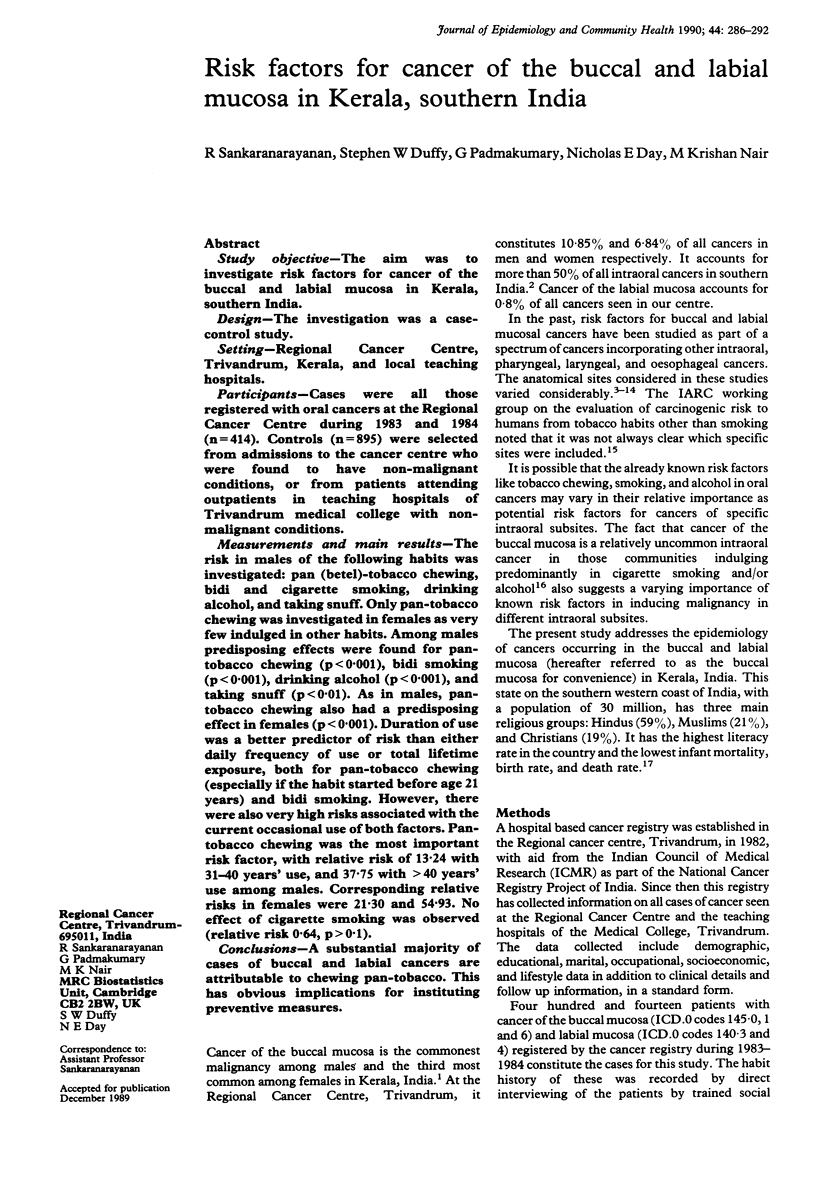
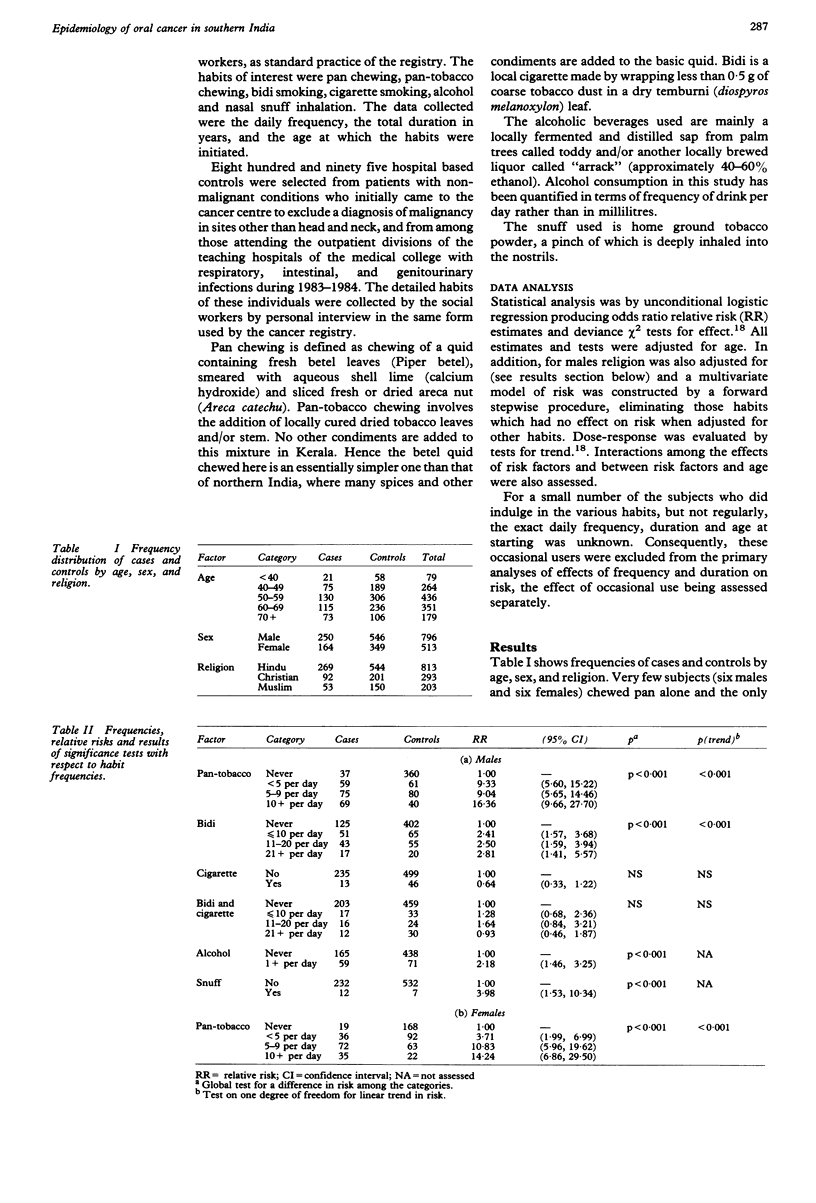
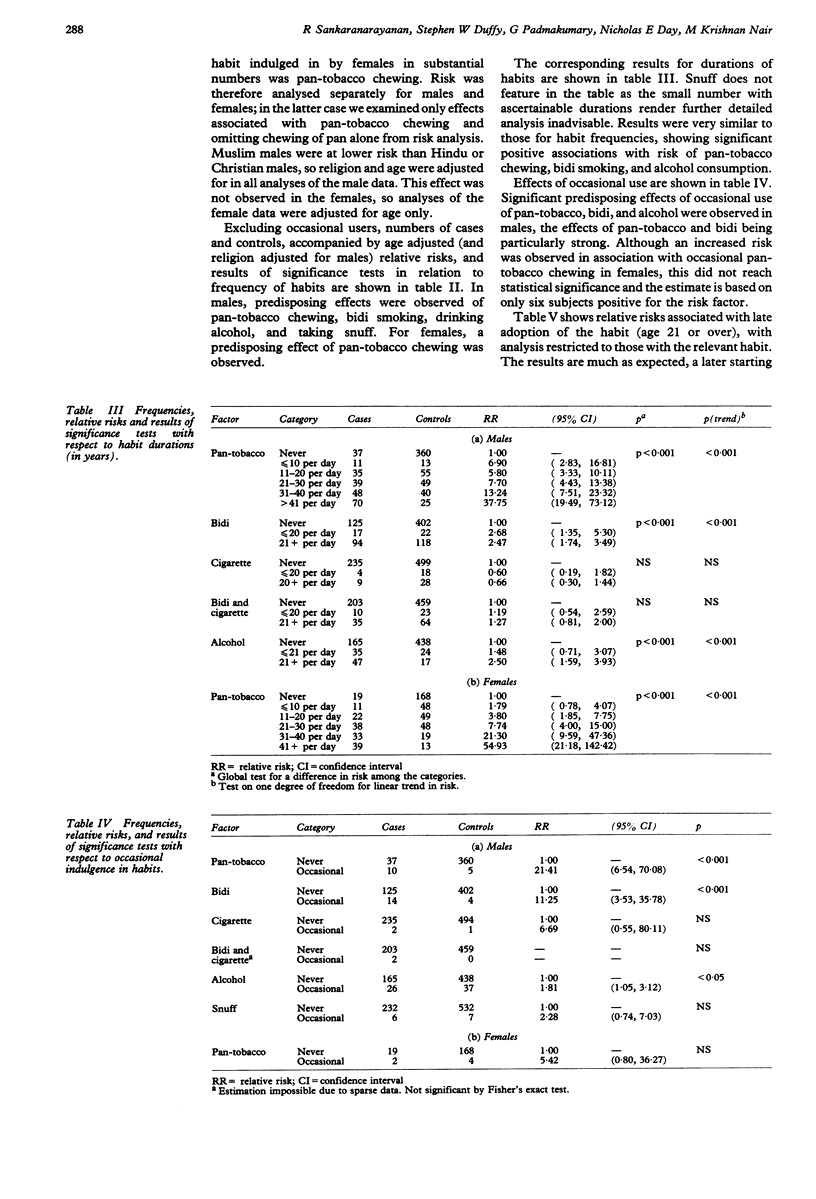
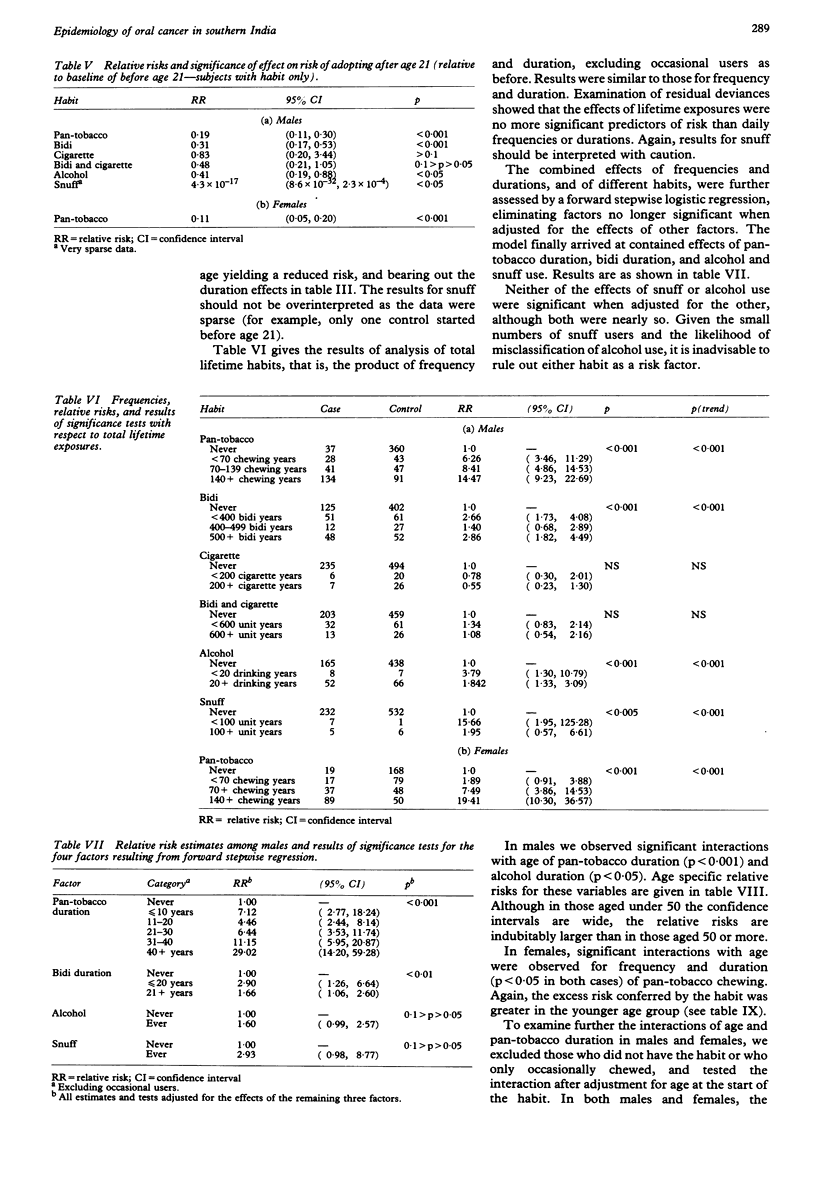
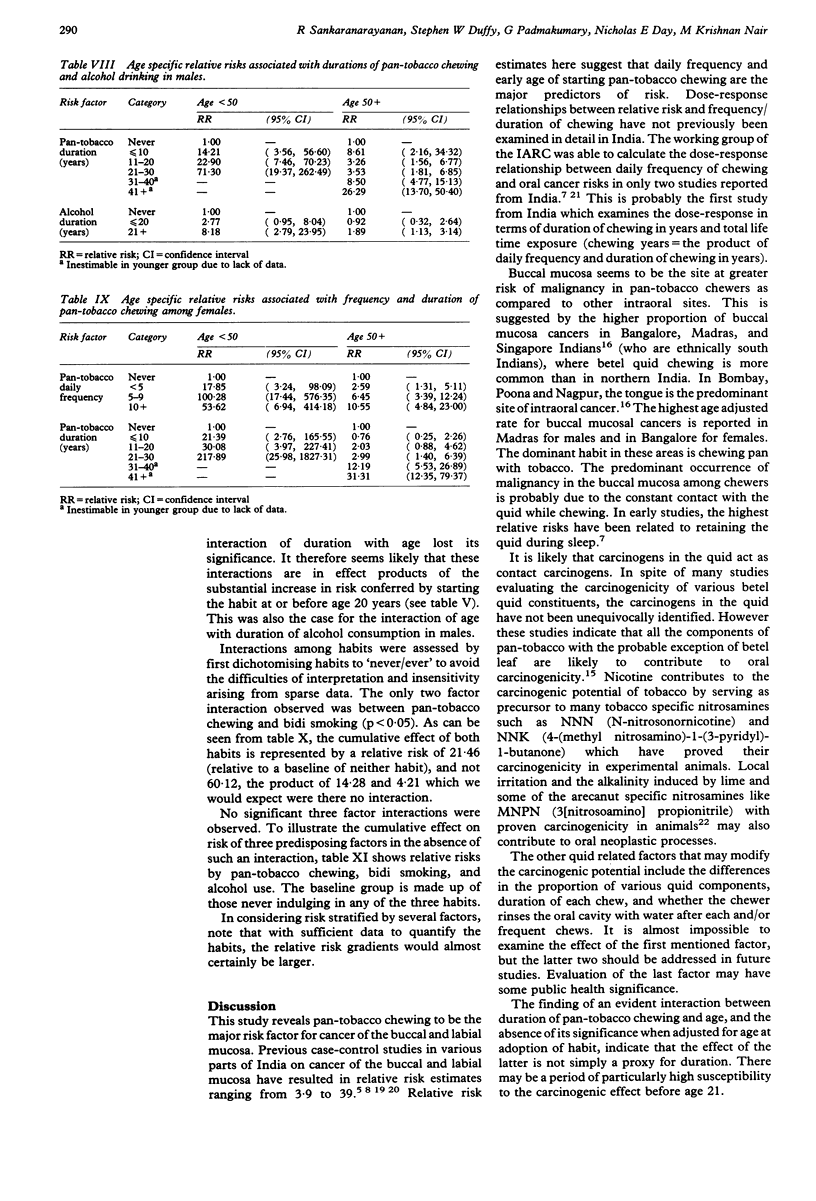
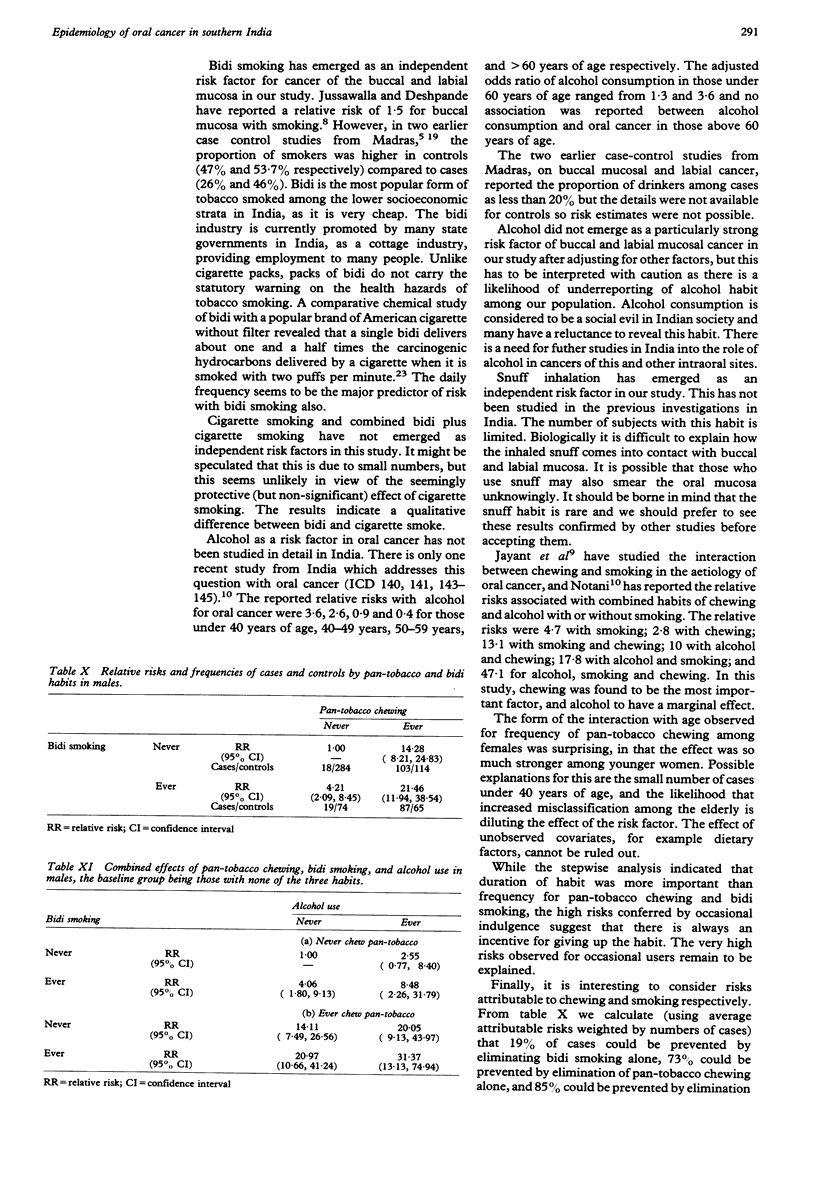
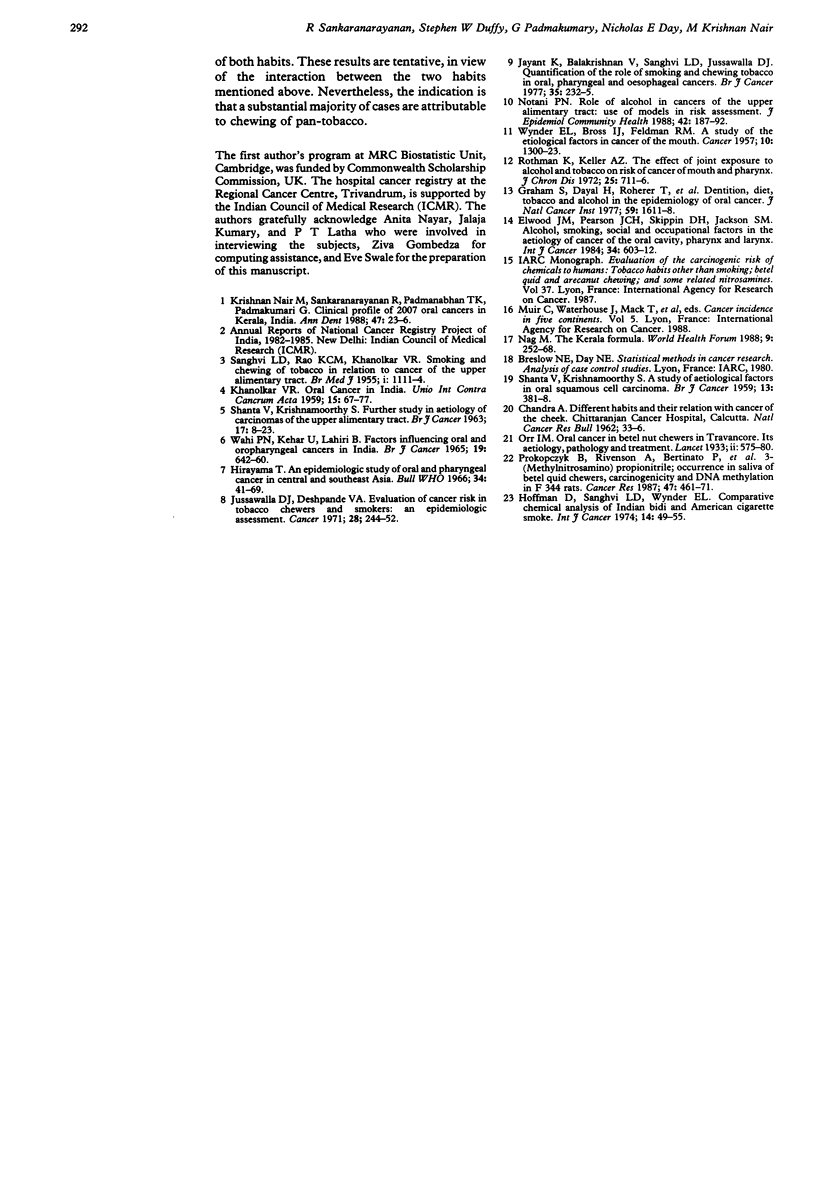
Selected References
These references are in PubMed. This may not be the complete list of references from this article.
- Elwood J. M., Pearson J. C., Skippen D. H., Jackson S. M. Alcohol, smoking, social and occupational factors in the aetiology of cancer of the oral cavity, pharynx and larynx. Int J Cancer. 1984 Nov 15;34(5):603–612. doi: 10.1002/ijc.2910340504. [DOI] [PubMed] [Google Scholar]
- Graham S., Dayal H., Rohrer T., Swanson M., Sultz H., Shedd D., Fischman S. Dentition, diet, tobacco, and alcohol in the epidemiology of oral cancer. J Natl Cancer Inst. 1977 Dec;59(6):1611–1618. doi: 10.1093/jnci/59.6.1611. [DOI] [PubMed] [Google Scholar]
- Hirayama T. An epidemiological study of oral and pharyngeal cancer in Central and South-East Asia. Bull World Health Organ. 1966;34(1):41–69. [PMC free article] [PubMed] [Google Scholar]
- Hoffmann D., Sanghvi L. D., Wynder E. L. Comparative chemical analysis of Indian bidi and american cigarette smoke. Int J Cancer. 1974 Jul 15;14(1):49–53. doi: 10.1002/ijc.2910140107. [DOI] [PubMed] [Google Scholar]
- Jayant K., Balakrishnan V., Sanghvi L. D., Jussawalla D. J. Quantification of the role of smoking and chewing tobacco in oral, pharyngeal, and oesophageal cancers. Br J Cancer. 1977 Feb;35(2):232–235. doi: 10.1038/bjc.1977.31. [DOI] [PMC free article] [PubMed] [Google Scholar]
- Jussawalla D. J., Deshpande V. A. Evaluation of cancer risk in tobacco chewers and smokers: an epidemiologic assessment. Cancer. 1971 Jul;28(1):244–252. doi: 10.1002/1097-0142(197107)28:1<244::aid-cncr2820280150>3.0.co;2-h. [DOI] [PubMed] [Google Scholar]
- KHANOLKAR V. R. Oral cancer in India. Acta Unio Int Contra Cancrum. 1959;15(1):67–77. [PubMed] [Google Scholar]
- Nair M. K., Sankaranarayanan R., Padmanabhan T. K., Padmakumari G. Clinical profile of 2007 oral cancers in Kerala, India. Ann Dent. 1988 Summer;47(1):23–26. [PubMed] [Google Scholar]
- Notani P. N. Role of alcohol in cancers of the upper alimentary tract: use of models in risk assessment. J Epidemiol Community Health. 1988 Jun;42(2):187–192. doi: 10.1136/jech.42.2.187. [DOI] [PMC free article] [PubMed] [Google Scholar]
- Rothman K., Keller A. The effect of joint exposure to alcohol and tobacco on risk of cancer of the mouth and pharynx. J Chronic Dis. 1972 Dec;25(12):711–716. doi: 10.1016/0021-9681(72)90006-9. [DOI] [PubMed] [Google Scholar]
- SANGHVI L. D., RAO K. C., KHANOLKAR V. R. Smoking and chewing of tobacco in relation to cancer of the upper alimentary tract. Br Med J. 1955 May 7;1(4922):1111–1114. doi: 10.1136/bmj.1.4922.1111. [DOI] [PMC free article] [PubMed] [Google Scholar]
- SHANTA V., KRISHNAMURTHI S. A study of aetiological factors in oral squamous cell carcinoma. Br J Cancer. 1959 Sep;13:381–388. doi: 10.1038/bjc.1959.43. [DOI] [PMC free article] [PubMed] [Google Scholar]
- SHANTA V., KRISHNAMURTHI S. Further study in aetiology of carcinomas of the upper alimentary tract. Br J Cancer. 1963 Mar;17:8–23. doi: 10.1038/bjc.1963.2. [DOI] [PMC free article] [PubMed] [Google Scholar]
- WYNDER E. L., BROSS I. J., FELDMAN R. M. A study of the etiological factors in cancer of the mouth. Cancer. 1957 Nov-Dec;10(6):1300–1323. doi: 10.1002/1097-0142(195711/12)10:6<1300::aid-cncr2820100628>3.0.co;2-2. [DOI] [PubMed] [Google Scholar]
- Wahi P. N., Kehar U., Lahiri B. Factors influencing oral and oropharyngeal cancers in India. Br J Cancer. 1965 Dec;19(4):642–660. doi: 10.1038/bjc.1965.80. [DOI] [PMC free article] [PubMed] [Google Scholar]


